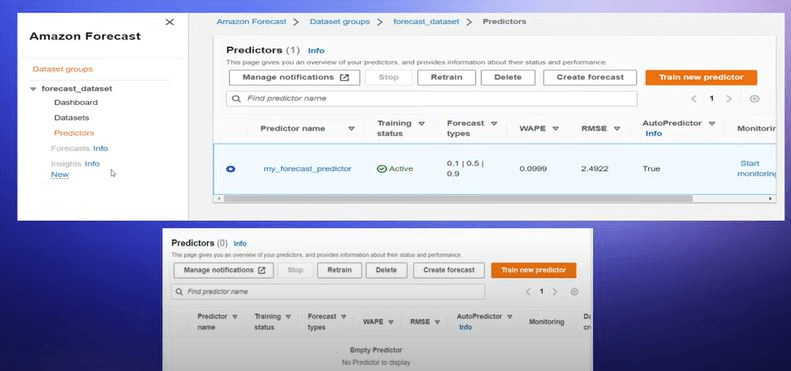No one can deny the importance of forecasting in this busy business world. And one tool that’s getting a lot of attention lately is Amazon Forecast. But many people don’t know “What is Amazon Forecast exactly and how to use it?”
Well. It is all about predicting what will happen by looking at what’s happened in the past. It can help allocate resources, plan production, manage stock, and more.
And that’s just the tip of the iceberg! In the present article, I will talk about what is Amazon Forecast. I will explore its benefits, real-world uses, and any limitations it might have. I will also give you some tips on how to get started.
Sounds good? Let’s dive in!
What Exactly is Amazon Forecast?
What Things Make Amazon Forecast Stand Out?
How Does the Amazon Forecast Work
How Amazon Forecast Can Help You?
Real-world Applications of the Amazon Forecast
What Exactly is Amazon Forecast?
At its core, Amazon Forecast is a service provided by Amazon Web Services (AWS). It uses advanced machine-learning techniques to predict future trends and patterns using historical data.
The importance of this tool cannot be overstated, as accurate forecasts enable companies to optimize their operations, streamline their processes, and make well-informed decisions that can significantly impact their success.
What Things Make Amazon Forecast Stand Out?
Well. Various things make the Amazon Forecast stand out. So, let’s discuss them one after another.
Accurate Data Analysis
The foundation of Amazon Forecast lies in data analysis. The service uses historical data to identify patterns, trends, and seasonality in your business’s past performance.
The more accurate and relevant the data you provide, the better the predictions. Therefore, ensuring your data is comprehensive and up-to-date is vital for getting precise forecasts.
Automated Machine Learning (AutoML)
AutoML is a crucial feature that makes Amazon Forecast accessible to a wide range of users, even those without extensive technical expertise.
AutoML automates the process of selecting the best forecasting model for your data and tuning its parameters. This way, it eliminates the need for complex manual configuration, making forecasting more approachable for non-experts.
Scaling and Elasticity
Amazon Forecast is designed to handle varying workloads and resource demands seamlessly. This means that whether your forecasting needs are small or large, the service can adapt to ensure efficient resource utilization.
This scalability is crucial for businesses that experience fluctuating demand throughout the year.
Customizable Forecasting Models
Amazon Forecast offers a variety of forecasting models, allowing you to choose the one that best fits your business’s specific needs.
Whether your data exhibits seasonal patterns, trends, or other complexities, there’s a model that can accommodate it. This customization ensures that your forecasts are tailored to your unique circumstances.
Forecast Confidence and Prediction Intervals
Forecasting is not just about predicting a single value. It’s also about understanding the level of confidence linked with that prediction.
Amazon Forecast provides prediction intervals, which indicate a range within which the actual value is likely to fall. This information helps decision-makers gauge the uncertainty of their forecasts and make more informed choices.
Built-in Algorithms
Amazon Forecast comes with a suite of pre-built algorithms optimized for different types of data and use cases.
These algorithms enhance the accuracy of your forecasts. And with a simple selection, you can benefit from these cutting-edge predictive capabilities.
How Does the Amazon Forecast Work
Now that you know “What is Amazon Forecast?” let’s move to the next part. Now, I will discuss how the Amazon Forecast works.

Step 1: Data Collection and Preparation
The first step in using Amazon Forecast is to collect historical data relevant to what you want to forecast.
It could include sales data, customer behavior, financial metrics, etc. The quality of your forecasts heavily relies on the quality of this data. After collecting it, format it properly to ensure accurate results.
Step 2: Choose a Model
Once your data is prepared, the next step is to choose a forecasting model. Amazon Forecast provides a range of model types, such as time series forecasting, deepAR, and more.
The choice of model depends on the nature of your data, whether it exhibits seasonality, trends, or other patterns.
Step 3: Train the Model
Training the chosen model involves feeding it with your historical data. The model then learns from this data, identifying patterns and relationships to make predictions.
Amazon Forecast handles much of the heavy lifting here, including automatically tuning the model’s parameters to achieve the best performance.
Step 4: Generate Forecasts
Once the model is trained, you can utilize it to generate future forecasts. Provide the model with a time frame, and it will return predictions along with their confidence intervals.
These confidence intervals provide a range within which the predicted values will likely fall, giving you a more nuanced understanding of the outcomes.
How Amazon Forecast Can Help You?
The Amazon Forecast can help you in various ways. Here are only some of its benefits.
Resource and Cost Optimization
Forecasting with Amazon Forecast helps optimize resource allocation and reduce costs. Businesses can avoid overstocking, which ties up capital and leads to potential wastage.
Similarly, understocking can result in missed sales and dissatisfied customers. Accurate forecasts empower companies to strike the right balance, minimizing waste and maximizing profits.
Time-Saving
Manual forecasting can be time-consuming and error-prone. Amazon Forecast’s automation streamlines the process, saving valuable time for your team.
This automation also minimizes the risk of human error, ensuring your forecasts are consistently accurate.
Aids in Pricing Strategies
Price optimization is critical in pricing-sensitive markets. Amazon Forecast can be used to predict how price changes might affect demand. This way, it helps in maximizing revenue while still meeting customer demand.
Data Security
The Amazon Forecast uses encryption to guarantee the security and confidentiality of your data. Additionally, you retain the ownership of all data, meaning it can only be utilized for machine learning with your explicit consent.
Real-world Applications of the Amazon Forecast
The Amazon Forecast has a range of real-world applications, such as:
Retail Industry
Amazon Forecast plays a crucial role in inventory management in the retail sector. By predicting customer demand, retailers can optimize their inventory levels. It means they will have the right products in stock when customers want them.
Financial Sector
In the financial world, accurate forecasts are vital for making investment decisions. Amazon Forecast can be used to predict stock market trends. This way, it can help investors make intelligent choices.
Additionally, financial institutions can use forecasts to manage investment portfolios and optimize their returns.
Supply Chain Management
In supply chain management, accurate demand forecasts are essential for efficient operations. Businesses can optimize production schedules, reduce lead times, and minimize inventory holding costs by predicting demand patterns.
Limitations and Considerations
Like all other things, the Amazon Forecast also has some limitations. So, let’s have a look at these limitations in some detail:
Data Quality and Availability
One limitation of Amazon Forecast, and forecasting in general, is its dependence on the quality and availability of data. If your historical data is incomplete or inaccurate, it can lead to less reliable forecasts.
Model Limitations
While Amazon Forecast is highly accurate, you must know that forecasts are not infallible. There will always be some level of uncertainty.
It mainly happens in situations with unpredictable external factors. The human judgment remains crucial in interpreting forecasts and making final decisions.
How to Get Started with Amazon Forecast?
Now, here is the most important section. Here, I will guide you on how to get started with the Amazon Forecast.
How to Set Up?
To get started with Amazon Forecast, you’ll need an AWS account. Once you have an AWS account, you can access the Amazon Forecast console through the AWS Management Console. Navigating the console is intuitive and user-friendly.
Upload Your Data
Then, upload your historical data. Amazon Forecast supports various data formats, making it easy to integrate your existing data sources. Follow the prompts to upload your data for analysis.
Create Your Forecast
With your data uploaded, you can create your first forecast. The process involves selecting the data source, specifying the forecast horizon, and choosing the forecasting model that best suits your data type.
After configuring these settings, Amazon Forecast will generate your forecasts and their confidence intervals.
Frequently Asked Questions about What is Amazon Forecast
Question No. 1: Is Amazon Forecast Suitable for Small Businesses?
Answer: Yes, Amazon Forecast caters to businesses of all sizes. Its automated machine-learning capabilities make it accessible even to those without technical expertise.
Question No. 3: How Accurate Are Amazon Forecast’s Predictions?
Answer: The accuracy of predictions depends on factors like data quality and model choice. Amazon Forecast provides confidence intervals to gauge the uncertainty connected with these projections.
Question No. 4: Can I Integrate Amazon Forecast with My Existing Systems?
Answer: Yes. Amazon Forecast offers APIs that allow integration with your existing systems. It enables seamless data transfer and incorporation of forecasts into your workflow.
Final Word
To sum up, forecasting is a fantastic tool that can help business corporations make informed decisions and stay ahead in a competitive landscape.
Amazon Forecast takes this concept to the next level. It leverages AutoML capabilities to provide accurate and actionable predictions.
From accurate data analysis to resource optimization and time savings, Amazon Forecast offers a wide range of benefits across various industries.
So, whether you’re in retail, finance, or supply chain management, consider integrating Amazon Forecast into your decision-making processes to unlock its potential for your business’s growth.
